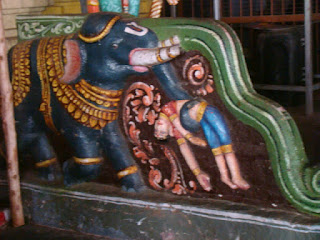Sri Rämaswämi
Temple, Kumbakonam
I would have just bypassed Sri
Ramaswami Temple unless Pujya Swamiji had specified to see it while going to
Kumbakonam. He said that it was the only temple, where Sita is on the same pitham as Rama. So naturally, I was
dying to see this unique temple.
The first visit was on 1st
July, 2010 night. The second more relaxed visit was next day 2nd
July 2010 morning. The third visit was on 16th August 2012, and in
the priority list was the third (after Kumbeçwara
and Särangapäni).
The Gopuram
The Carved Pillars
The sixty-two pillars in front of
the mandpam are great
works of art. They hold individually Räma
standing with Kodanda, Sitä,
Hanuman, Räma and Sitä
sitting together, many ornamental ladies, and a lady with sophisticated
footwear.
The Temple
After the mandapam, is the temple
entrance that has has two fierce-looking dvärapalas.
Below there are paintings of two
rogue elephants lifting two persons on their trunk.
The sanctum enshrines coronation form of Lord Räma. Huge stone image of both Sri Räma and Sri Sitä are seated on the same pitha (reportedly a rare honour given to Sri Sitä) flanked by brothers Bharata with cämara on Sita’s left, Lakshmana
holding the Kodanda on Räma’s right, Satrughna holding (?) standing further to Lakshmana,
on Räma’s right. Hanumän is placed facing Lord Räma playing a Vinä singing in His praise with a text in
his left hand. The colossal life-size images is similar as in Sri Rangam,
except that here they are in sitting and standing posture/s.
The utsava-vigraha of the Sri Räma, Sri Sitä,
Lakshmana and Hanumän
is placed before the mülavigraha.
Images of the mülavigraha, at least
of Sri Räma and Sri Sitä are clearly visible from the road.
Temple Paintings
Scenes from Rämäyana are painted on
three walls of the prakäram,
numbered and catalogued.
Some of the striking ones were
photographed by me. One can easily differentiate the limitation of a 2-dimensional
presentation of such paintings, after appreciating the three-dimensional
presentation introduced in Indian Art by Raja Ravi Verma.
A priest was chanting Rämäyana,
and refused to accept our dakshinä.
***
Work in progress
***



















